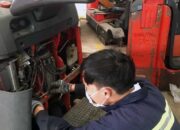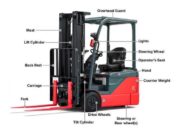Occupational Safety When Using Forklifts: Essential Regulations to Know
In industrial environments such as warehouses, factories, or construction sites, forklifts have become indispensable tools due to their ability to quickly and efficiently transport and lift goods. However, if not operated correctly, forklifts can pose significant risks, leading to serious workplace accidents that affect both people and property. Therefore, understanding and adhering to occupational safety regulations when operating warehouse forklifts is crucial to ensuring a safe working environment.
Regulations on Forklift Training and Certification
To operate a forklift safely and effectively, workers must be equipped with the necessary knowledge and skills through comprehensive training courses. According to legal regulations, anyone intending to drive a forklift must possess a valid operator’s certificate. These training programs typically consist of two main components:
- Theoretical Knowledge: Trainees learn about the forklift’s structure, the functions of components such as the lifting system, brakes, wheels, and basic safety principles. They are also instructed on how to handle emergency situations, such as a forklift tipping over or goods falling.
- Practical Operation: This hands-on section allows workers to familiarize themselves with operating a forklift in real-world conditions, from navigating tight spaces to lifting and lowering heavy loads.
Upon completing the course, workers must pass an evaluation conducted by authorized agencies to obtain their certification. This not only fulfills legal requirements but also boosts operators’ confidence when working with warehouse forklifts, minimizing the risk of incidents.
Regulations on Forklift Inspection and Maintenance
A well-functioning forklift is a critical factor in ensuring safety during operation. Therefore, before each shift, operators should thoroughly inspect the vehicle’s key components, including:
- Braking System: Ensure the brakes are responsive and free from slipping or jamming, as they determine the forklift’s ability to stop promptly.
- Lights and Warning Signals: Verify that these devices are functioning properly to alert surrounding personnel when the forklift is in motion.
- Lifting System: Check the forks, cables, and hydraulics for signs of oil leaks or damage.
- Power Source: For fuel-powered (gasoline, diesel) or electric (battery-operated) forklifts, confirm there’s sufficient energy for the entire shift.
In addition to daily checks, regular maintenance following the manufacturer’s guidelines is mandatory. Routine maintenance helps identify and address potential issues early, extending the forklift’s lifespan and ensuring safety. If you’re using services from Samcovina Company, a reputable provider of forklift sales and rentals, you’ll benefit from thoroughly inspected and maintained forklifts ready to meet your operational needs.
Regulations on Safe Operation
When operating a warehouse forklift, workers must strictly follow safety protocols to protect themselves and those around them:
- Speed Control: Operate the forklift at an appropriate speed, especially in crowded areas or narrow pathways. Excessive speed can lead to collisions or tip-overs.
- Personal Protective Equipment (PPE): Operators must wear helmets, slip-resistant shoes, and protective clothing to minimize injury risks in case of an accident.
- No Passengers: Unless the forklift is specifically designed with an additional seat, carrying people on the forks or body of the vehicle is strictly prohibited due to the high risk of accidents.
Adhering to these regulations not only reduces risks but also fosters a professional and safe working environment.
Regulations on Load Capacity and Handling Goods
Proper management of load capacity and goods handling is key to ensuring safety when using a forklift:
- Do Not Exceed Maximum Load: Each forklift has a specified weight limit outlined in its technical documentation. Exceeding this limit can damage the vehicle or cause it to tip over.
- Careful Load Placement: Goods should be evenly positioned on the forks, secured with straps if necessary, and must not obstruct the driver’s view.
- Maintain Balance: When lifting or moving, ensure the load is evenly distributed to prevent the forklift from tilting, especially with heavy items.
Following these guidelines protects both the operator and the goods while minimizing property damage risks.
Regulations on the Working Environment
A safe working environment is the foundation for effective forklift operation. Businesses should implement the following measures:
- Clear Pathways: Remove obstacles such as cables or scattered materials to allow the forklift to move safely and easily.
- Use Warning Signals: Install signs, flashing lights, or painted lines in hazardous areas to alert surrounding personnel.
- Provide Adequate Lighting: Ensure the workspace, especially in warehouses, is well-lit so operators can see clearly.
Maintaining a compliant working environment not only boosts productivity but also significantly reduces the risk of workplace accidents.







